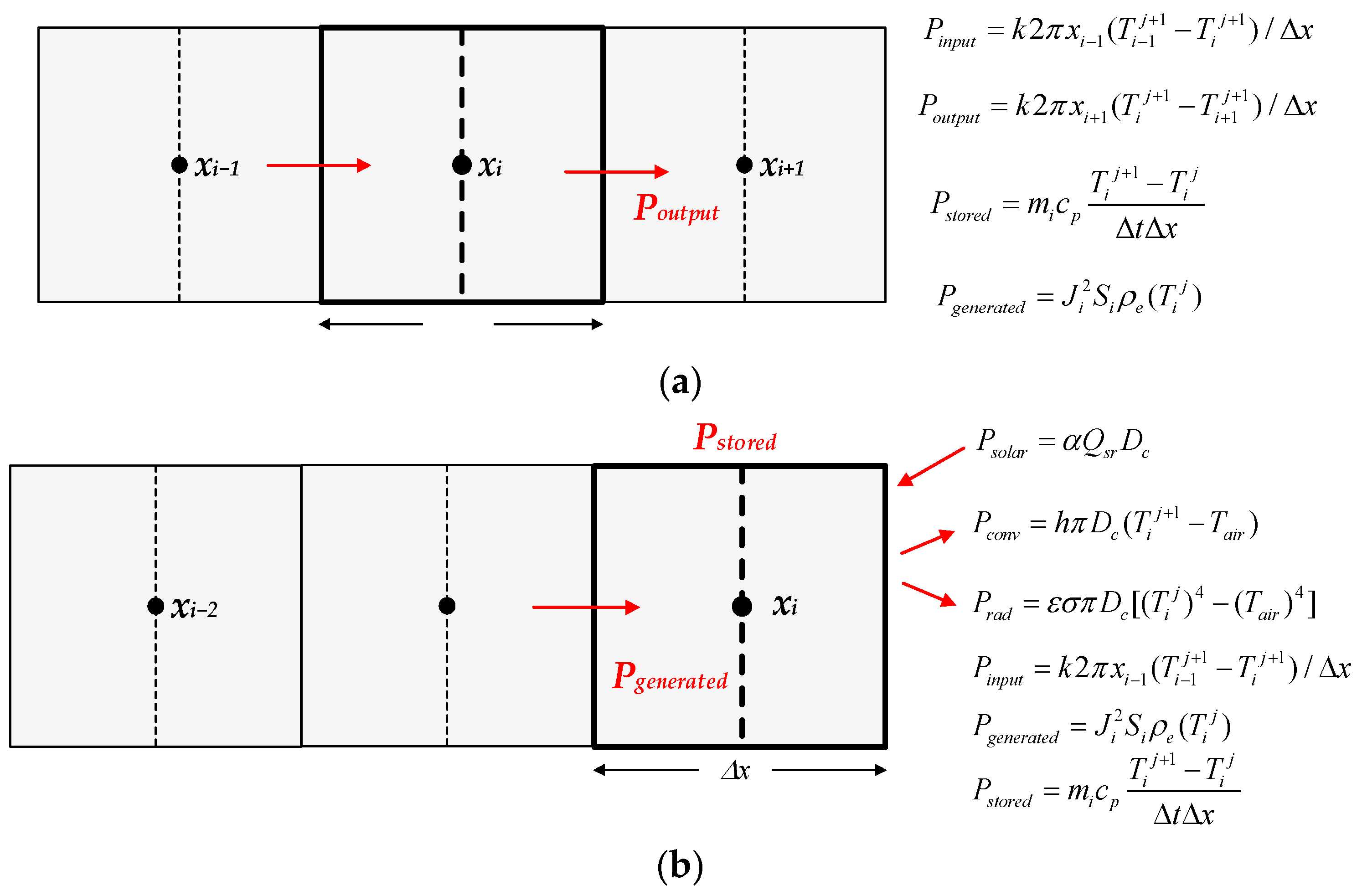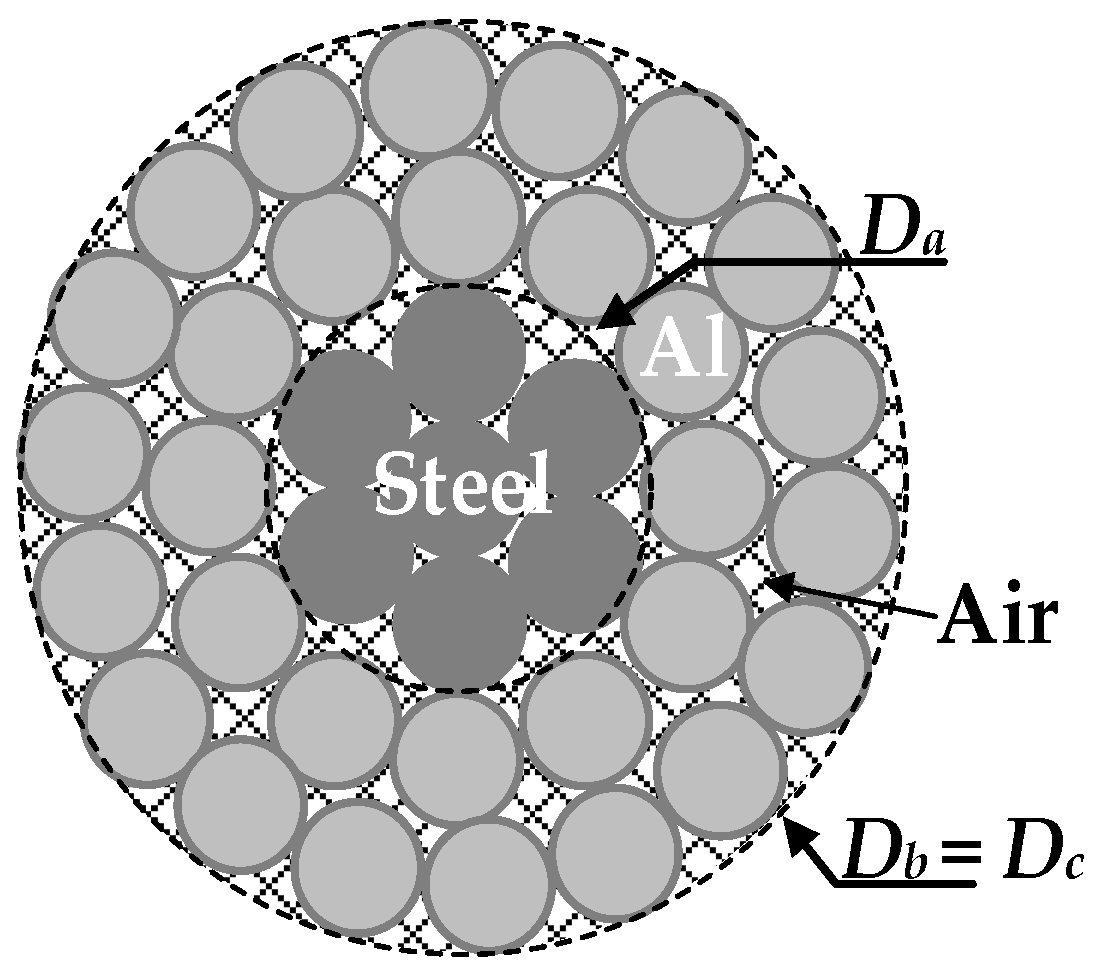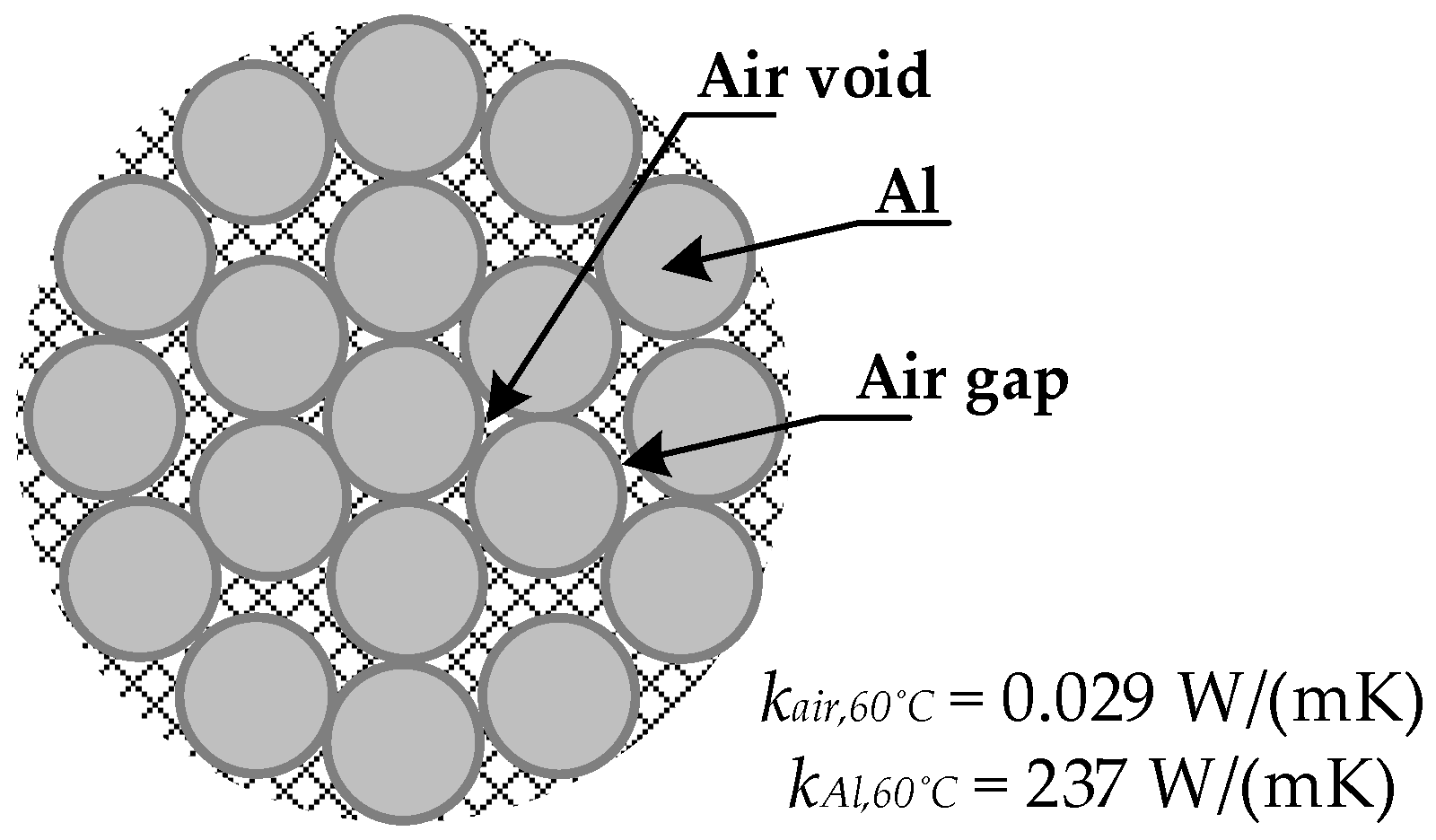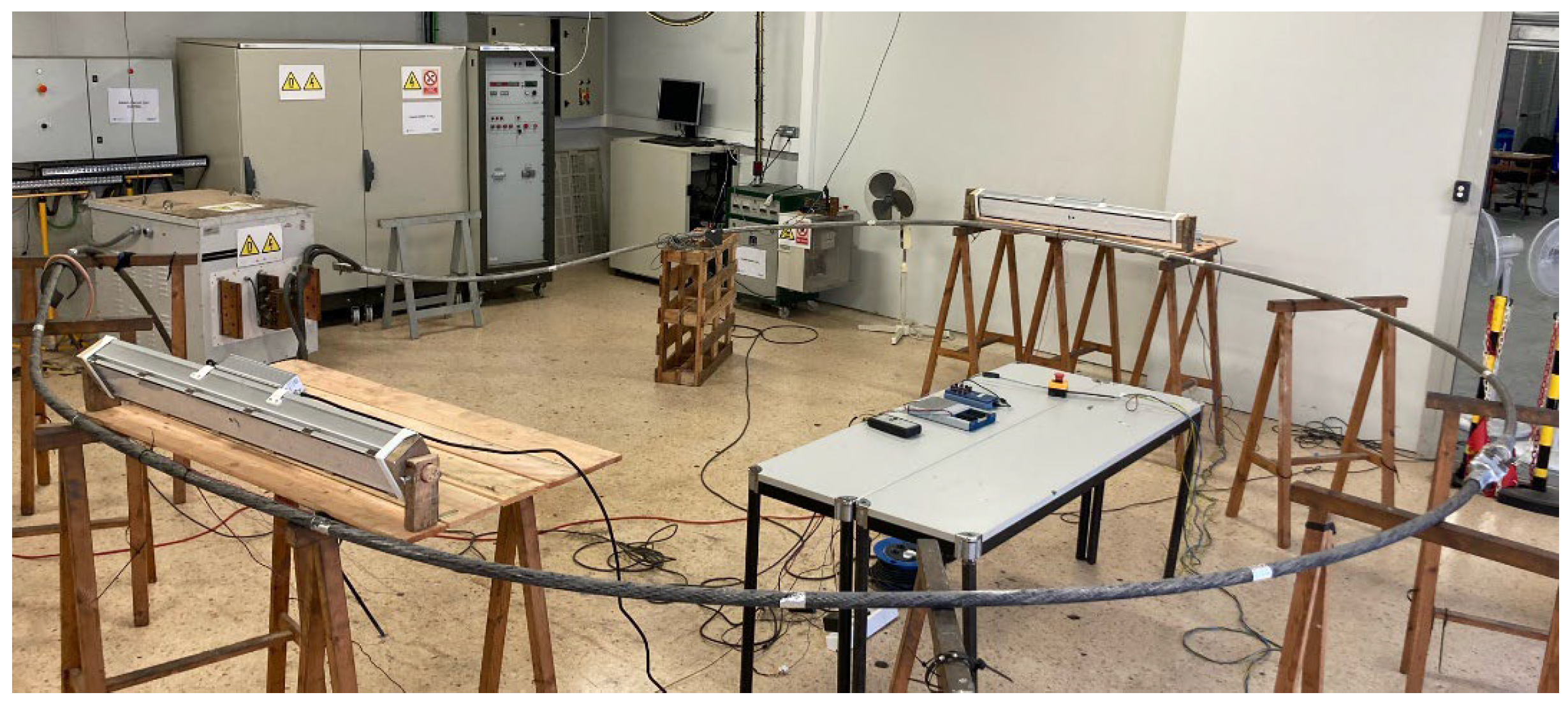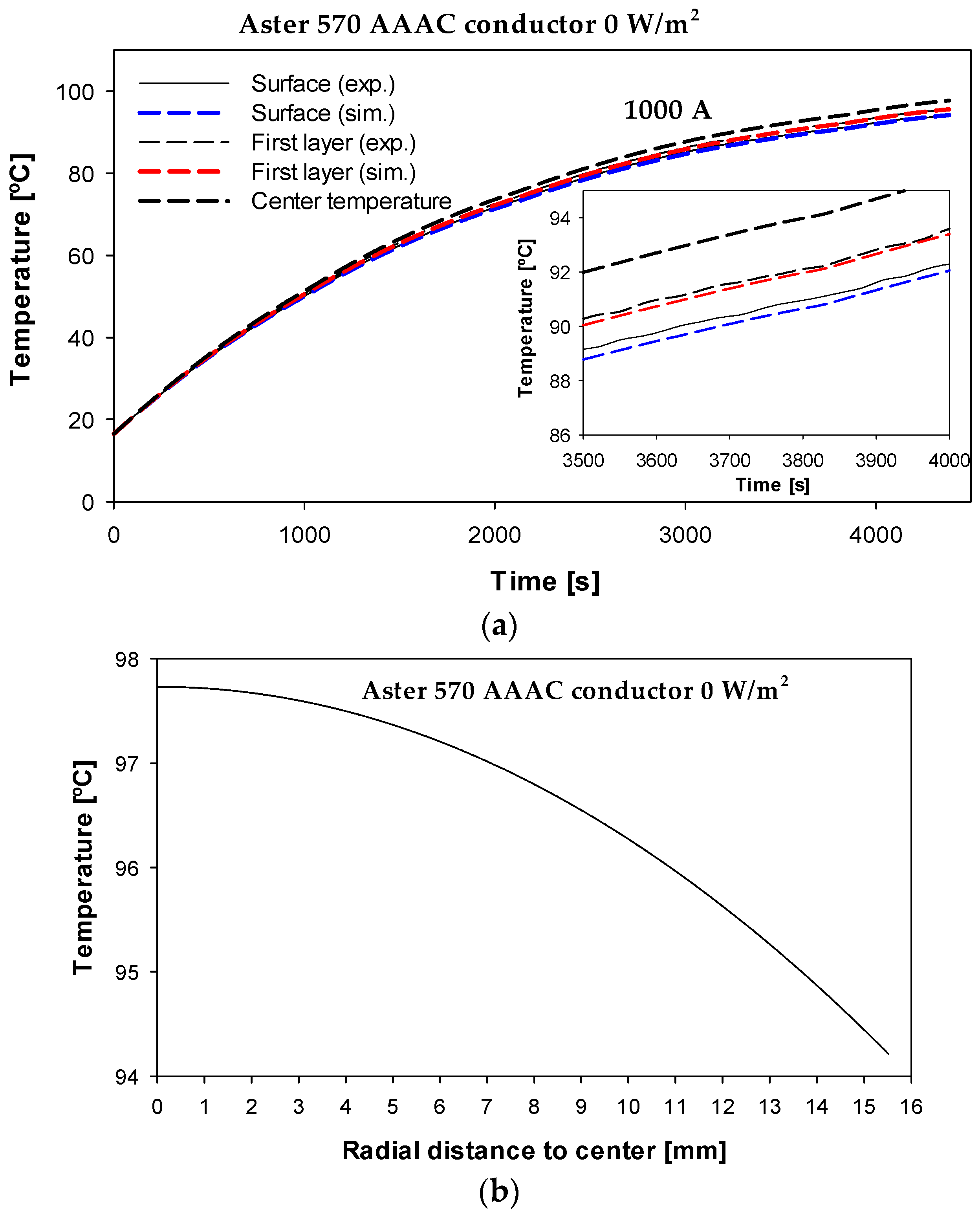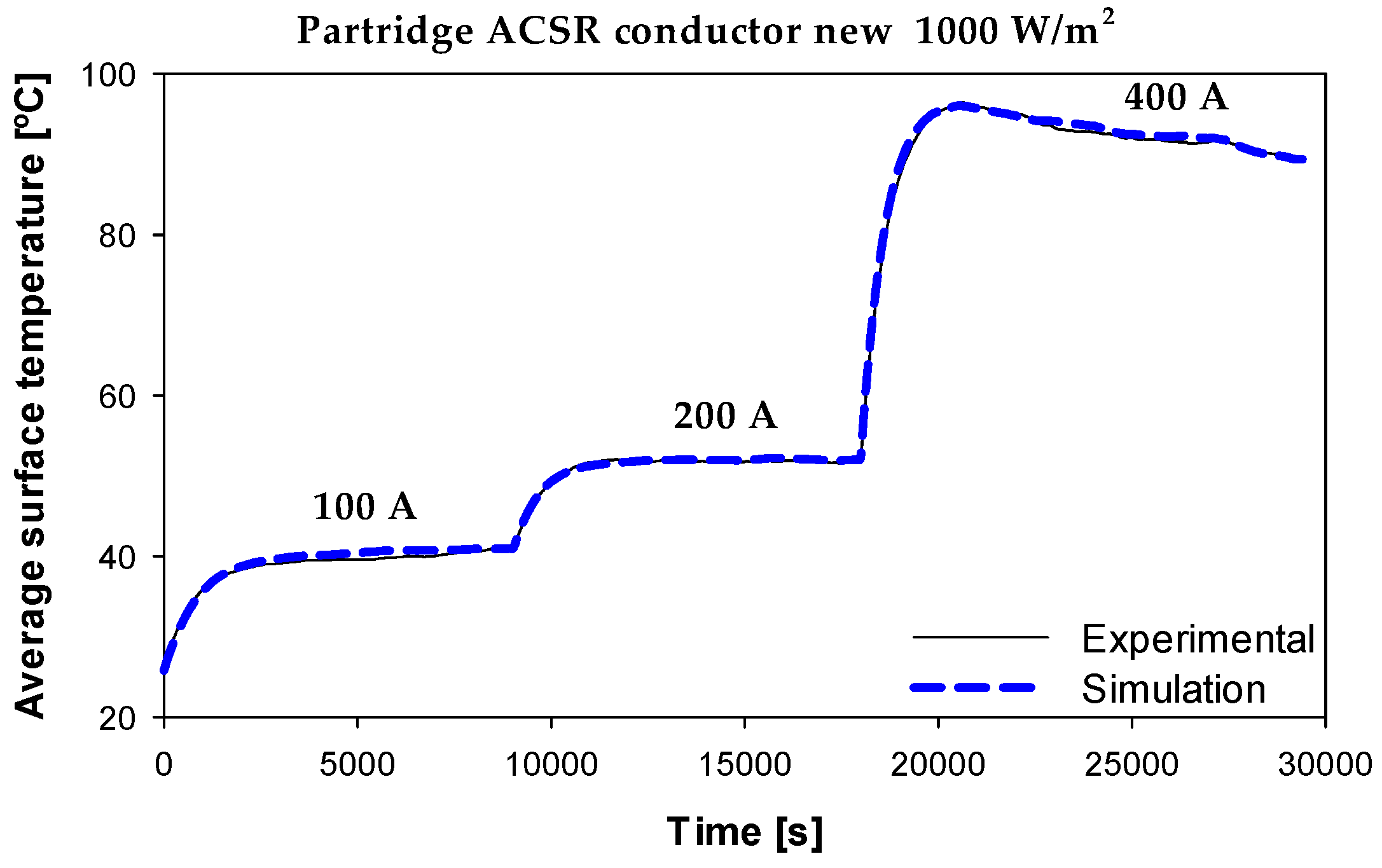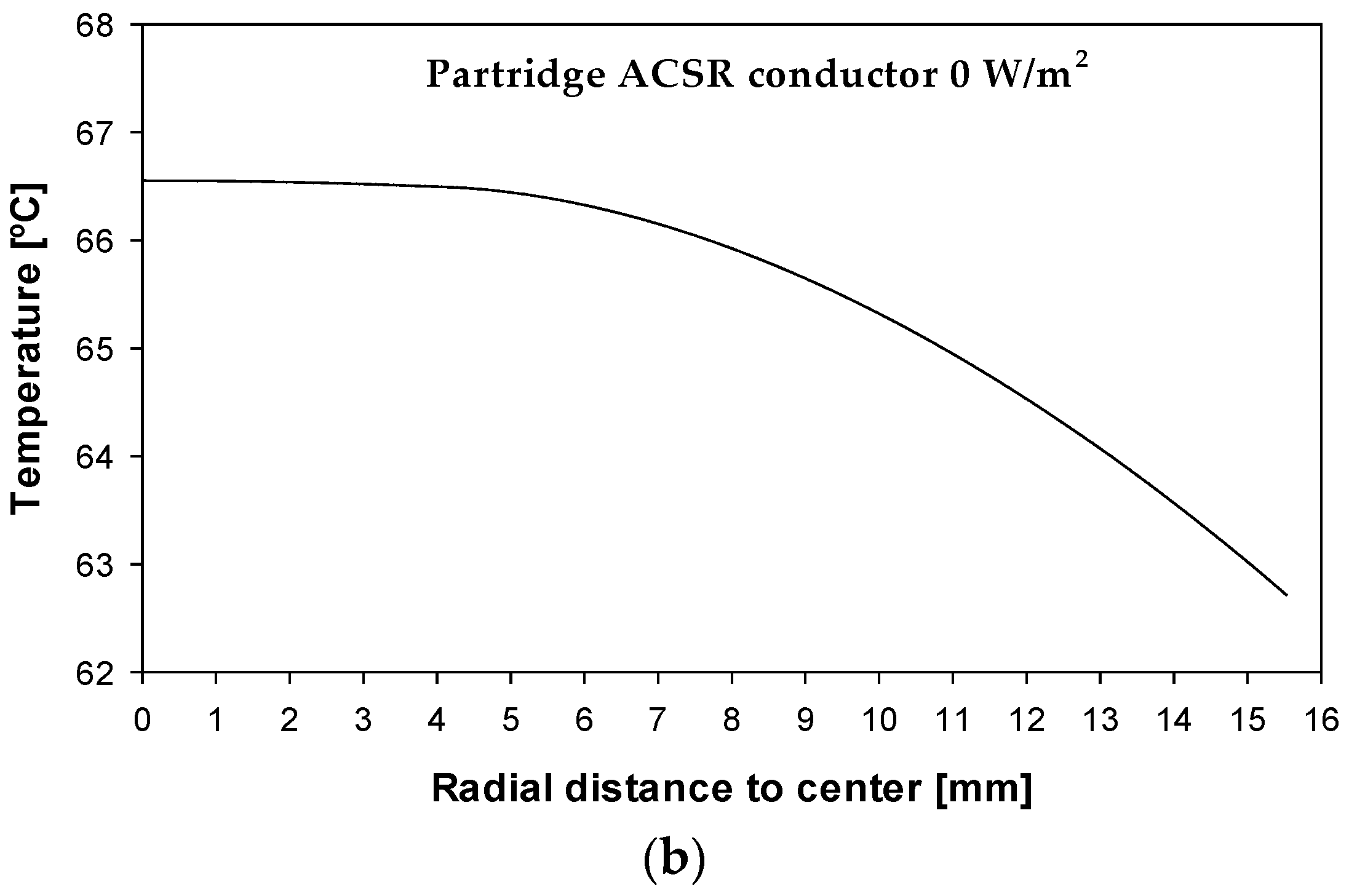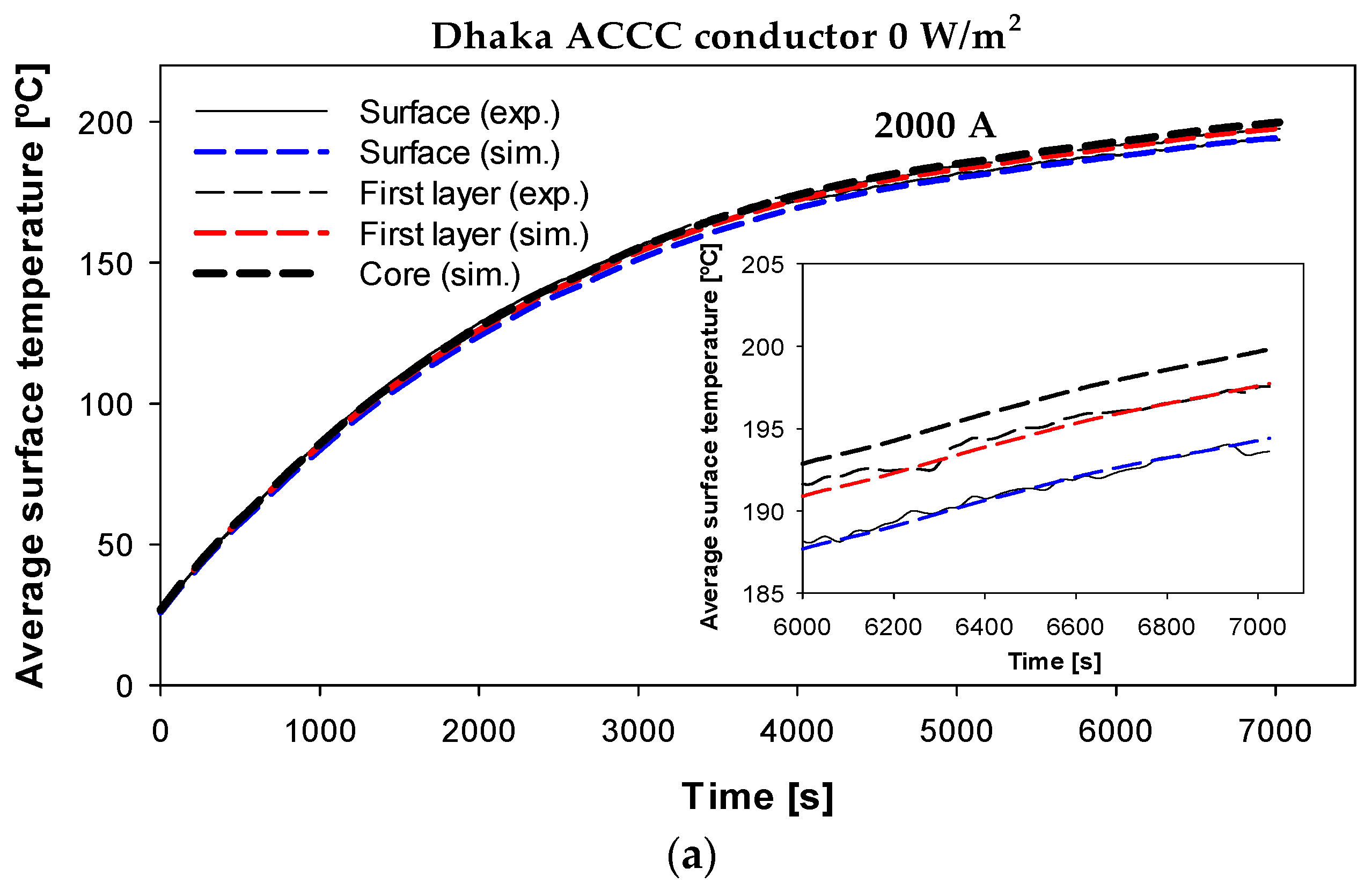1. Introduction
Global demand for electricity has been growing steadily, and projections indicate that this trend will continue. According to projections by the International Energy Agency (IEA), the share of electricity in final energy consumption is expected to increase from 20% today to more than 50% by 2050 [
1]. The efficiency, reliability and availability of power lines will become increasingly important as electrification continues [
2], so operators need reliable methods to operate overhead transmission lines at maximum capacity [
3] without compromising their safety. Conductor sag is a key parameter for the safe operation of overhead transmission lines [
4], as it determines the ground clearance. By limiting the maximum operating conductor temperature, sag, ground clearance [
2,
5] and conductor integrity [
6] can be maintained at safe levels. Transmission lines occasionally operate at maximum design ratings [
7]. Due to various factors, the construction of new transmission lines is very problematic today, so other options to increase the capacity of existing power lines are being analyzed, such as replacing existing aluminum conductors steel reinforced (ACSRs) with high-temperature low-sag (HTLS) conductors or by applying dynamic line rating (DLR) strategies. Unlike static line rating (SLR), which applies conservative ratings based on the worst-case weather conditions (emissivity = 0.8, high annual ambient temperature, wind speed of 0.5 m/s and solar irradiance of 1000 W/m
2 [
7]), DLR is based on real-time weather ratings [
8,
9,
10]. By considering actual values of the solar irradiance, wind speed and direction and ambient temperature, combined with the application of DLR line models, a more realistic line rating can be determined [
11,
12], allowing the full capacity of the line to be utilized [
13].
DLR approaches require the measurement of several variables, including conductor current and temperature and weather-related variables, such as ambient temperature, solar irradiance and wind speed and direction [
14,
15]. Next, the conductor heat balance equation is solved using methods such as those presented in Cigré [
11], IEEE [
12] or IEC [
16], which also require knowledge of all conductor dimensions and material properties of the conductors. By solving the dynamic transient heat equation, it is possible to determine the maximum conductor rating. The DLR must ensure the stability of the transmission line at high operating currents while respecting the maximum allowable temperature of the conductor to ensure that safe limits of sag and annealing effect on the aluminum material are not exceeded [
17]. For this purpose, it is essential to have a detailed thermoelectric model of the conductor, capable of predicting not only the surface temperature but also the higher internal temperatures of the conductor.
However, most of the models published in the technical literature assume a homogeneous temperature distribution within the conductor [
11,
12,
16], which is a simplification of reality. Although this assumption may be correct in many cases, it can lead to non-negligible deviations in others, e.g., when considering ACSR conductors with at least three aluminum layers and high current densities [
18], so that differences between 10 °C and 25 °C [
12] up to 30 °C [
19] have been reported. Various authors have obtained formulas for determining the radial temperature distribution of power conductors [
11,
12,
17,
19,
20]. However, they make different assumptions, such as steady-state operation or uniform radial electrical conductivity, and do not allow the development of a transient model by themselves. In addition, most of these references provide experimental results, but they lack the development of a transient model capable of determining the thermal behavior of the conductor, taking into account the radial temperature distribution.
The temperature of the conductor results from a thermal balance between the heating terms (Joule and solar heating) and the cooling terms (radiative and convective cooling). If the heating terms are greater than the cooling terms, the conductor heats up; otherwise, it cools down. In these cases, the difference between the heat input and the heat output is the stored power term (see
Section 2 for more details). While the radiative and convective cooling terms depend on the surface temperature, the Joule heating and stored power terms depend on the internal or average temperature of the conductor. Therefore, existing models that assume a homogeneous temperature distribution lack this detailed analysis because they assume no difference between the surface temperature and the center temperature of the conductor.
Therefore, a transient thermoelectric radial model of bare-stranded conductors is required. This can be achieved by modifying the standard methods used for calculating the maximum current carrying capacity of a conductor described in the standards [
11,
12,
16] to account for the higher core temperature of the conductor [
17].
The novelties and contributions of this paper are as follows. First, it focuses on improving the thermoelectric transmission line conductor models described in the international standards [
11,
12,
16] to consider the radial temperature distribution in order to have a more accurate picture of the temperature distribution within the conductor. Second, this paper proposes an accurate and fast one-dimensional thermoelectric conductor model that considers the radial temperature distribution and assumes that the heat flows radially from the center of the core to the outer surface. Third, results showing how the radial temperature distribution affects the conductor heating are also presented. Fourth, the paper also presents experimental results of three types of conductors, namely, an all-aluminum alloy conductor (AAAC), an aluminum conductor steel reinforced (ACSR), and an aluminum conductor composite core (ACCC), a type of high-temperature low-sag (HTLS) conductor. Experimental results allow the accuracy and usefulness of the radial model presented in this paper to be evaluated.
The remainder of the paper is organized as follows.
Section 2 develops the transient heat transfer equations and their components.
Section 3 details the proposed one-dimensional discretization of the problem to determine the radial temperature distribution within the conductor.
Section 4 details the importance of effective radial thermal conductivity in the proposed model.
Section 5 develops the equations to solve the proposed radial model.
Section 6 describes the transmission line conductors analyzed and the experimental setup.
Section 7 validates the proposed radial model from the experimental results. Finally,
Section 8 concludes this paper.
2. Transient Heat Balance Equation
This section develops the different terms in the transient heat balance equation that describe the thermoelectric behavior of a bare conductor [
11,
12,
21],
where
m (kg/m) is the conductor mass per unit length,
cp(
T) (J/(kg °C)) is the specific heat capacity of the conductor material,
T (°C) is the average temperature of the conductor,
Pinternal (W/m) is the term related to the internal power losses generated in the conductor per unit length,
Psolar (W/m) is the solar heat gain per unit length,
Pconv (W/m) is the convective cooling term per unit length and
Prad (W/m) is the radiative cooling per unit length. For a better understanding, the terms in (1) are shown in
Figure 1.
According to (1), under thermal equilibrium, the total heat loss is equal to the total heat gain. Under transient conditions, where there is no thermal equilibrium, the difference between the total heat gain and the total heat loss is the neat heat stored in the conductor [
11]. The various terms in (1) are developed in
Section 2, but
Pinternal = i2(
t)
rAC(
T) (W/m) is the internal heating, where
i(
t) (A) is the RMS value of the current measured at time instant
t (s) and
rAC (W/m) is the alternating current (AC) resistance per unit length of the conductor.
While the terms
Pinternal = i2(
t)
rAC(
T) and
Pstored =
mcp(
T)d
T/d
t depend on the average conductor temperature
T, the terms
Pconv and
Prad depend on the conductor surface temperature. Note that
Pinternal = i2(
t)
rAC(
T) is usually the main source of heating, and the AC resistance depends on the temperature distribution inside the conductor. In addition, effects such as creep, annealing and sag of the conductor are strongly affected by the radial temperature distribution within the conductor [
22]. Therefore, accurate thermoelectric conductor models must take into account the temperature distribution within the conductor.
2.1. Stored Heat
Under transient conditions, i.e., without thermal equilibrium, the heat stored in the conductor per unit length can be expressed as,
2.2. Internal Heating
ACSR conductors consist of an inner core of galvanized steel strands and several layers of aluminum strands wound helically around the steel strands [
23]. While the core provides the mechanical strength [
24], the aluminum strands carry most of the current [
25]. Due to the specific configuration and the magnetic properties of the steel core, the ac magnetic flux causes eddy currents, hysteresis losses in the core and a redistribution of the currents in the aluminum layers [
18,
26], increasing the conductor’s AC resistance [
24]. The internal losses
Pinternal can be determined as [
8,
21,
27,
28],
The internal losses have various components, namely the Joule losses (PJoule), the core losses due to the hysteresis and eddy current effects (Pmag) and the redistribution losses (Predis). According to (3), the internal losses are related to the AC resistance per unit length of the conductor rAC (Ω/m) and the electric current i(t).
In the case of conductors without a magnetic core, this results in Pinternal = PJoule since Pmag = Predis = 0.
The electrical resistivity
ρe of the conductor changes with temperature according to,
where
T0 is the reference temperature (usually 293.15 K),
T (K) is the average temperature of the conductor temperature, and
αAC (K
−1) is the temperature coefficient of the resistivity under alternating current. The temperature dependence of the conductor resistance per unit length
rAC(
T) follows a similar law,
Since
Pinternal is by far the largest source of heat in power conductors [
8,
27],
rAC is an important parameter for building accurate thermoelectric models of conductors because it accounts for magnetic and eddy current effects. Note that
rAC can be calculated from
rDC (it is typically found in the manufacturers’ datasheets) using the procedure described in [
11], or it can be measured directly as described in [
28]. In this paper,
rAC is measured directly.
2.3. Natural Convective Heat Loss
According to IEEE Std. 738 [
12], assuming a cylindrical conductor of outer diameter
Dc (m), the natural convective heat loss per unit length can be calculated as follows,
where
Ts (K) and
Tair (K) are the conductor surface temperature and air temperature, respectively, and
h (W/(m
2K)) is the heat transfer coefficient, which can be calculated under natural convection conditions (no wind, worst case) according to IEEE Std. 738 [
12] as,
Note that the air density
ρair (kg/m
3), which depends on the conductor height
H (m), and the temperatures of the air and the outer surface of the conductor,
Tair (K) and
Ts (K), respectively, can be determined as [
12],
2.4. Radiative Heat Loss
The radiative heat loss per unit length of the conductor can be calculated as [
11],
where
ε (-) is the dimensionless emissivity coefficient and
σB = 5.67037 × 10
−8 W/(m
2K
4) is the Stefan–Boltzmann constant. The effect of this term becomes very important at high conductor temperatures.
2.5. Solar Heat Gain
The solar heat gain
Psolar (W/m) can be calculated as [
11,
16],
where
α ∈ [0, 1] and is the absorptivity of the conductor and
Qsr (W/m
2) is the total solar irradiance. This formulation is convenient because global radiation meters are now affordable, reliable and widely available. According to (10), the effect of solar heating increases with the conductor diameter [
29]. Note that according to Kirchhoff’s law of thermal radiation,
α ≈
ε. This equality also holds for non-equilibrium processes where radiative emission is produced exclusively by microscopic thermal transitions [
30].
3. One-Dimensional Discretization of the Radial Temperature Distribution Problem
Although the conductors are made of aluminum strands with very good conductivity, they have a radial temperature distribution that cannot be neglected, especially when the conductors are operated at high temperatures. The terms
Pinternal and
dT/
dt in the heat balance Equation (1) depend on the average internal temperature of the conductor, while the terms
Pconv and
Prad depend on the surface temperature. Since these two temperatures are different, it is necessary to know the radial temperature distribution of the conductor. To determine the radial temperature distribution, it is assumed that the heat flows radially from the center of the core to the outer surface. Due to the cylindrical geometry, a symmetric radial distribution can be assumed, allowing the problem to be discretized in one dimension, as shown in
Figure 2.
The one-dimensional radial discretization shown in
Figure 2 consists of
j = 1, …,
n =
Na +
Nb + 1 nodes. It is assumed that the nodal temperatures of a generic node
i can be determined from the nodal temperatures of the two adjacent nodes to the left and right sides. While the first node
j = 1 is located in the center of the conductor (center of the core), the last node
j =
n is located in the periphery of the conductor (outer surface). The discretized form of the heat transfer problem expressed by (1) is solved through the radial axis as,
where
aij,
bij,
cij and
dij are constant coefficients,
i is the index related to the radial steps and
j is the index related to the time steps. Thus,
Tij =
T(
iΔ
x,
jΔ
t) represents the average temperature of node
i calculated at the
j time step, where Δ
x is the radial step and Δ
t is the time step.
Note that (11) determines the node temperatures from the temperatures of the adjacent right and left nodes. Equation (11) can be expressed in terms of a tri-diagonal matrix containing the node temperatures as,
Using the tri-diagonal matrix algorithm (TDMA) approach [
31,
32], the node temperatures of all radial nodes are obtained for each simulation time
jΔ
t. Next, the Thomas algorithm, a simplified version of Gaussian elimination that speeds up the computational process [
33], can be used to solve (12). Further details on the discretization procedure and the application of the TDMA algorithm can be found in [
31,
32].
3.1. Discretized Heat Balance Equation in a Generic Discrete Radial Element
According to Fourier’s law, the heat flow rate per unit length in the radial direction in an isotropic cylindrical conductor of diameter
Dc (m) can be written as follows,
where
k (W/(mK)) is the thermal conductivity of the material, and d
T/d
x (K/m) is the derivative of the absolute temperature in the radial direction. Equation (13) can be expressed in discrete form as,
Figure 3 shows the heat balance in a generic inner element and in the outermost element,
3.2. TDMA Formulation
To solve the problem, it is necessary to determine the electrical resistance and the electrical current through each discrete element. Therefore, it is necessary to determine the electrical resistivity ρe,i (Ω·m) and the current density Ji = I/Si (A/m2) in each discrete element, where I (A) and Si = πxi2 (m2) are the electrical current flowing through the conductor and the cross-sectional area of the discrete element number i, and xi (m) is the radial position of node i. The resistance per unit length of this discrete element can be calculated as ri = ρe,i/Si (Ω/m).
The heat transfer equation in a generic element (see
Figure 3) can be expressed as,
Since
Pgeneratred = (
JiSi)
2ri =
Ji2Siρe(
Tij), the discretized heat transfer equation in a given internal element (there is no solar heating or convective and radiative cooling) can be expressed as,
where
cp (J/(kgK)) is the specific heat capacity of the material,
mi =
ρSiΔ
x (kg) is the mass of the
i-th discrete element and
Tij (K) is the absolute temperature of that discrete element at time
t =
jΔ
t (s), while
ρ (kg/m
3) is the volumetric mass density of the material.
3.3. Particularities of ACSR Conductors
ACSR conductors have a core composed of stainless steel strands and a conductor body composed of aluminum strands, as shown in
Figure 4.
Due to the higher electrical conductivity of aluminum, most of the current (approximately 98% [
25]) flows through the aluminum strands. The following procedure is used to determine the current densities in the steel core strands and in the aluminum strands. First, the geometric cross-section of the core and the conductor parts can be calculated as
Sa = π·
Da2/4 and
Sb = π·
Db2/4 −
Sa (m
2), respectively, where
Da (m) and
Db =
Dc (m) are the outer diameters of the core and the aluminum part, respectively. It should be noted that the geometric cross-sections
Sa and
Sb do not coincide with the effective cross-sections of the steel and aluminum parts,
Seff,a and
Seff,b, respectively, due to the air voids and air gaps existing between the strands.
The mass per unit length of the core and the conductor parts, ma (kg/m) and mb (kg/m), respectively, are typically specified by the conductor manufacturer. Thus, the mass density of the core and aluminum parts can be determined as ρa = ma/Sa (kg/m3) and ρb = mb/Sb (kg/m3), respectively.
Since the current density through the steel strands is very low, their electrical resistivity can be taken as the tabulated value,
ρe,a = 6.9 ×·10
−7 Ω·m. However, since the current density through the aluminum strands is high and
Sb >
Seff,b, the electrical resistivity of the conductor part used in the calculations can be determined as follows,
where
rAC (Ω/m) is the AC resistance per unit length of the conductor, which includes the effects of eddy currents and core losses. Note that (17) is derived from the parallel between the electrical resistances per unit length of the core
ra and the conductive part
rb. Once the resistivity
ρe,a and
ρe,b of both parts are known, the currents
ia and
ib in each part of the conductor can be calculated as,
6. Conductors Analyzed and Experimental Setup
To validate and evaluate the accuracy of the proposed radial model, this paper analyzes three different conductors, an all-aluminum alloy conductor (AAAC), an ACSR conductor and a high-temperature low-sag (HTLS) conductor, which are described in the following sections.
6.1. AAAC Conductors
AAAC conductors use a high-strength aluminum alloy to achieve good sag characteristics and a high strength-to-weight ratio. All strands are made of high-strength aluminum alloy, so there is no steel core. AAAC conductors offer higher corrosion resistance compared to ACSR conductors.
This paper analyzes the thermal behavior of the Aster 570 AAAC conductor, which has 61 aluminum strands and a 1/6/12/18/24 distribution, as shown in
Figure 6.
Table 1 shows the main parameters of the Aster 570 AAAC conductor.
6.2. ACSR Conductors
As explained above, ACSR conductors consist of multiple layers of aluminum strands wound helically around an inner core made of galvanized steel strands. While the aluminum strands carry most of the electrical current, the steel strands provide the mechanical strength. This paper also analyzes the thermal behavior of a two-layer ACSR conductor (Partridge 135-AL1/22-ST1A, EMTA Kablo, Istanbul, Turkey). This conductor has a steel core with seven steel strands (1/6 steel configuration) and two conductive aluminum layers with 10 and 16 aluminum strands (10/16 aluminum configuration).
Figure 7 shows the Partridge 135-AL1/22-ST1A ACSR conductor.
Table 2 shows the main parameters of the Partridge 135-AL1/22-ST1A ACSR conductor, which consists of 7 steel strands with a 1/6 distribution and 26 aluminum strands with a 10/16 distribution.
6.3. HTLS Conductors
An HTLS conductor-type aluminum conductor composite core (ACCC) with trapezoidal wire (TW), also known as ACCC/TW, was analyzed. To limit sag at high temperatures, this HTLS conductor has a non-conductive, lightweight and high-strength hybrid core of carbon and glass fibers embedded in a resin matrix [
38]. Fully annealed and helically wound trapezoidal aluminum strands surround the hybrid core. These fully annealed aluminum strands are purer and more conductive than the strands used in conventional ACSR conductors. The continuous operating temperature of these conductors is approximately 180 °C [
39].
Figure 8 shows the cross-section of the ACCC/TW used in this work and the location of the thermocouples (black dots).
Table 3 shows the main parameters of the three-layer Dhaka ACCC/TW conductor.
6.4. Experimental Setup
The tests were performed in an indoor high-current laboratory. All tested conductors were connected to the output of the high-current transformer (0–10 V output voltage, 0–10 kA output current), forming a low-impedance loop.
Since the experiments were conducted indoors, LED projectors (Series AGRO-K, average photosynthetic photon flux density 430 μMol/m2/s, Venalsol, Valencia, Spain) were used to simulate the solar irradiance. The global solar irradiance was measured with a global radiation meter (PCE-SPM 1, silicon sensor, 400–1100 nm, 0–2000 W/m2, 0.1 W/m2, accuracy ± 10 W/m2, PCE Instruments, Southampton, UK).
The AC resistance per unit length rAC of the conductors was determined experimentally from (5) by measuring the voltage drop across a 1 m length of conductor and the phase shift between the voltage drop and the current.
The current flowing through the loop was measured with a Rogowski coil (CWT500LFxB, 0.06 mV/A sensitivity, ±1% current accuracy, PEM, Nottingham, UK). The data provided by the Rogowski coil and the voltage drop in the conductors were acquired using an NI USB-6343 data acquisition card (National Instruments, Dallas, TX, USA), from which the phase shift between the voltage drop and the current can be determined, and thus the AC resistance per unit length rAC.
Low inertia T-type thermocouples were used to measure the surface temperature of the conductors. The data provided by the thermocouples was acquired using a thermocouple input module (TC08, ±1 °C, Omega, Northbank, Manchester, UK).
A Python code was used to synchronize the measurements taken with the TC08 thermocouple input module and the NI USB-6343 data acquisition card.
The experimental setup is shown in
Figure 9.
To avoid heat sink effects from the edges, the conductors were long enough (about 8–10 m each) and measurements were made in the center of the conductor [
17].
Different thermocouples were placed on the outer surface of each conductor to determine the average surface temperature. To measure the internal temperature, thermocouples were also implanted directly into different layers of the conductor, forcing adjacent strands to open and taking care not to deform the geometry of the conductor once in place. Thermal paste was used to improve the thermal contact between the thermocouples and the aluminum strands. The test setup was located indoors, which allowed measurements to be made at zero wind speed.
8. Conclusions
Stranded conductors are critical elements of overhead power lines. A radial thermal gradient is created as the internal heat generated is conducted to the outer surface. In order to fully utilize the current-carrying capacity of the conductor and to ensure safe operation, e.g., when developing accurate conductor line models to apply dynamic line rating (DLR) strategies, this effect must be taken into account because two important terms of the heat transfer equation—i.e., the internal heating, which is the main source of heating, and the stored heat, which strongly affects the dynamics of the heat transfer—depend on the internal temperature distribution. In addition, annealing, creep and sag effects are strongly influenced by the radial temperature distribution within the conductor. Therefore, accurate thermoelectric conductor models must take into account the temperature distribution within the conductor.
This paper has presented a radial one-dimensional thermoelectric model for bare-stranded conductors. The accuracy of the proposed model has been evaluated through experimental tests performed on three types of conductors, namely AAAC, ACSR and ACCC-HTLS conductors. The experimental results presented in this paper show that the thermal gradient between the center and the outer surface of the conductor can be predicted with accuracy using the proposed radial one-dimensional model, which improves the capabilities of the models proposed in the IEC, Cigré and IEEE standards, especially when designing DLR approaches. In particular, the results presented under different conditions (varying current density, solar irradiance and temperature range) show that the average differences between the laboratory results and the results of the radial model are usually less than 1%, which proves the accuracy of the proposed model. The results presented in this paper have also shown the superior accuracy of the proposed radial model with respect to the results of the model that considers a homogeneous temperature distribution inside the conductor.


